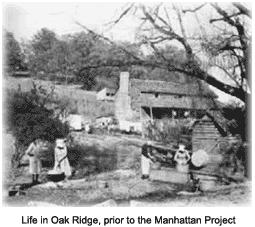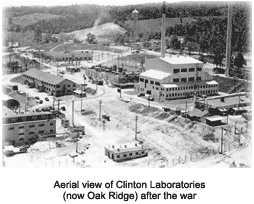The facilities at Oak Ridge, Tennessee, code named "Clinton Engineer Works," were part of The Manhattan Project. Scientists, working on the atomic bomb, needed to find sufficient fuel for the reactors, which meant using uranium (U-235) or plutonium (Pu-238) — the only suitable substances known by 1942. Project leaders did not know how quickly or how much of each they could produce, so they decided to produce both at the same time.
The first mission at Oak Ridge was to design reactors that could produce plutonium. The reactor design was then supplied to the Hanford Reservation, where full-scale production was undertaken. The second mission was to produce the U-235 isotope of uranium at sufficient purity and in sufficient quantity to make a bomb. Prior to this, separation of U-235 on an industrial scale had never been attempted.
 Some 60,000 acres of ridges and valleys that made up the area surrounding Oak Ridge was chosen as a major site for the Manhattan Project because of the close proximity to the new TVA dam at Norris, Tennessee. This afforded electrical power, availability of labor, and a relatively sparse population. The communities of Scarboro, New Hope, Robertsville, Elza, and Wheat, Tennessee, were chosen and given notice that all 3,000 residents were to vacate their properties immediately to support the war effort. Residents were given a matter of weeks to remove their possessions and relocate. To most, this meant leaving behind land that had been in their families` possession for generations.
Three huge facilities were built at the site to test three new techniques for separating the isotopes of uranium. One isotope, U-235, found in less than one percent of naturally occurring uranium, is suitable for an atomic chain reaction. The challenge for the Manhattan Project was to separate the U-235 isotope from the U-238 isotope. Eventually, all three techniques developed at Oak Ridge contributed to the production of the necessary ingredients for the bomb dropped on Hiroshima on August 6, 1945. The speed and scale of the operations were staggering.
Three methods existed for extracting U-235: the electromagnetic process, gaseous diffusion, and thermal diffusion. Oak Ridge crews built a plant for each method. Each of the facilities was a gamble on a grand scale.
General Leslie Groves, director of the Manhattan Project, ordered that the first facility, code named Y-12, which was used for electromagnetic separation, be completed in less than six months. The peak operating force at Y-12 totaled 22,842 employees. Later, the plant also played a key role in the production of thermonuclear weapons.
The second plant, named K-25, built to house the gaseous diffusion process, consisted of 50 four-story buildings in a U-shape, measuring a half-mile by 1,000 feet, and covering more than 1,500 acres. When it was completed in March 1945, the K-25 facility was the largest building in the world under one roof.
The third facility, S-50, was constructed in 90 days, and involved 2,142 columns, each more than 40 feet tall. That facility used thermal diffusion.
The primary mission of the X-10 Graphite Reactor, built in just 11 months, was to demonstrate the production of plutonium from uranium in a reactor. The reactor operated from 1943 to 1963 and produced the first electricity from nuclear energy.
Electric energy consumption, courtesy of the TVA, was 20 percent higher than that of New York City. Oak Ridge used one-seventh of all the electricity produced in the United States. Nevertheless, in April 1945, none of the three enrichment processes was working well, and time was running out. J. Robert Oppenheimer decided to run the three in sequence rather than in parallel. The first step was thermal diffusion, which produced about two percent concentration. When this slightly improved product was fed into the gaseous diffusion process, it resulted in 23 percent concentration. A final pass through electromagnetic separation raised the concentration to 84 percent, which proved to be sufficient for a bomb.
Some 60,000 acres of ridges and valleys that made up the area surrounding Oak Ridge was chosen as a major site for the Manhattan Project because of the close proximity to the new TVA dam at Norris, Tennessee. This afforded electrical power, availability of labor, and a relatively sparse population. The communities of Scarboro, New Hope, Robertsville, Elza, and Wheat, Tennessee, were chosen and given notice that all 3,000 residents were to vacate their properties immediately to support the war effort. Residents were given a matter of weeks to remove their possessions and relocate. To most, this meant leaving behind land that had been in their families` possession for generations.
Three huge facilities were built at the site to test three new techniques for separating the isotopes of uranium. One isotope, U-235, found in less than one percent of naturally occurring uranium, is suitable for an atomic chain reaction. The challenge for the Manhattan Project was to separate the U-235 isotope from the U-238 isotope. Eventually, all three techniques developed at Oak Ridge contributed to the production of the necessary ingredients for the bomb dropped on Hiroshima on August 6, 1945. The speed and scale of the operations were staggering.
Three methods existed for extracting U-235: the electromagnetic process, gaseous diffusion, and thermal diffusion. Oak Ridge crews built a plant for each method. Each of the facilities was a gamble on a grand scale.
General Leslie Groves, director of the Manhattan Project, ordered that the first facility, code named Y-12, which was used for electromagnetic separation, be completed in less than six months. The peak operating force at Y-12 totaled 22,842 employees. Later, the plant also played a key role in the production of thermonuclear weapons.
The second plant, named K-25, built to house the gaseous diffusion process, consisted of 50 four-story buildings in a U-shape, measuring a half-mile by 1,000 feet, and covering more than 1,500 acres. When it was completed in March 1945, the K-25 facility was the largest building in the world under one roof.
The third facility, S-50, was constructed in 90 days, and involved 2,142 columns, each more than 40 feet tall. That facility used thermal diffusion.
The primary mission of the X-10 Graphite Reactor, built in just 11 months, was to demonstrate the production of plutonium from uranium in a reactor. The reactor operated from 1943 to 1963 and produced the first electricity from nuclear energy.
Electric energy consumption, courtesy of the TVA, was 20 percent higher than that of New York City. Oak Ridge used one-seventh of all the electricity produced in the United States. Nevertheless, in April 1945, none of the three enrichment processes was working well, and time was running out. J. Robert Oppenheimer decided to run the three in sequence rather than in parallel. The first step was thermal diffusion, which produced about two percent concentration. When this slightly improved product was fed into the gaseous diffusion process, it resulted in 23 percent concentration. A final pass through electromagnetic separation raised the concentration to 84 percent, which proved to be sufficient for a bomb.
 Oak Ridge, Tennessee, existed for seven years as a "secret city." The city grew to a population of 75,000 and was the fifth largest in Tennessee. It was not shown on any maps, did not allow any visitors other than by special approval, had guards posted at the entrances, and required all residents to wear badges at all times when outside their homes.
Today, Oak Ridge is a thriving community. The city is home to the Spallation Neutron Source, one of the largest basic science projects in the world. It also is noted for developing the world`s fastest computer, storing the nation`s supply of weapons-grade enriched uranium, remanufacturing the nation`s nuclear stockpile, and remediating the various contaminated structures, equipment, and land that remained from the nuclear operations at Oak Ridge. The site of the Graphite Reactor has been registered as a National Historic Landmark, and the control room and reactor face are accessible to visitors.
After World War II ended and the Cold War began, K-25 continued to provide the U-235 required for nuclear weapons, reactors, and submarines until it was closed in 1985. The Y-12 site manufactures, processes, and stores special materials that are vital to national security today, and also contributes to the prevention of the spread of weapons of mass destruction. Today, the American Museum of Science and Energy tells the story of the "Secret City" and its historic role in winning the war.
Oak Ridge, Tennessee, existed for seven years as a "secret city." The city grew to a population of 75,000 and was the fifth largest in Tennessee. It was not shown on any maps, did not allow any visitors other than by special approval, had guards posted at the entrances, and required all residents to wear badges at all times when outside their homes.
Today, Oak Ridge is a thriving community. The city is home to the Spallation Neutron Source, one of the largest basic science projects in the world. It also is noted for developing the world`s fastest computer, storing the nation`s supply of weapons-grade enriched uranium, remanufacturing the nation`s nuclear stockpile, and remediating the various contaminated structures, equipment, and land that remained from the nuclear operations at Oak Ridge. The site of the Graphite Reactor has been registered as a National Historic Landmark, and the control room and reactor face are accessible to visitors.
After World War II ended and the Cold War began, K-25 continued to provide the U-235 required for nuclear weapons, reactors, and submarines until it was closed in 1985. The Y-12 site manufactures, processes, and stores special materials that are vital to national security today, and also contributes to the prevention of the spread of weapons of mass destruction. Today, the American Museum of Science and Energy tells the story of the "Secret City" and its historic role in winning the war.